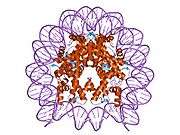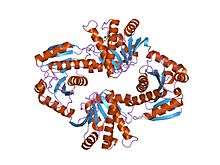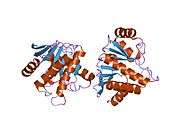H2AFY
| View/Edit Human | View/Edit Mouse |
Core histone macro-H2A.1 is a protein that in humans is encoded by the H2AFY gene.[3][4][5]
Function
Histones are basic nuclear proteins that are responsible for the nucleosome structure of the chromosomal fiber in eukaryotes. Nucleosomes consist of approximately 146 bp of DNA wrapped around a histone octamer composed of pairs of each of the four core histones (H2A, H2B, H3, and H4). The chromatin fiber is further compacted through the interaction of a linker histone, H1, with the DNA between the nucleosomes to form higher order chromatin structures. This gene encodes a member of the histone H2A family. It replaces conventional H2A histones in a subset of nucleosomes where it represses transcription and participates in stable X chromosome inactivation. Alternative splicing results in multiple transcript variants encoding different isoforms.[5] Expression of these isoforms is associated to several cancers, such as hepatocellular carcinoma.[6]
References
- ↑ "Human PubMed Reference:".
- ↑ "Mouse PubMed Reference:".
- ↑ Mao M, Fu G, Wu JS, Zhang QH, Zhou J, Kan LX, Huang QH, He KL, Gu BW, Han ZG, Shen Y, Gu J, Yu YP, Xu SH, Wang YX, Chen SJ, Chen Z (Jul 1998). "Identification of genes expressed in human CD34(+) hematopoietic stem/progenitor cells by expressed sequence tags and efficient full-length cDNA cloning". Proceedings of the National Academy of Sciences of the United States of America. 95 (14): 8175–80. doi:10.1073/pnas.95.14.8175. PMC 20949
 . PMID 9653160.
. PMID 9653160. - ↑ Lee Y, Hong M, Kim JW, Hong YM, Choe YK, Chang SY, Lee KS, Choe IS (Jul 1998). "Isolation of cDNA clones encoding human histone macroH2A1 subtypes". Biochimica et Biophysica Acta. 1399 (1): 73–7. doi:10.1016/s0167-4781(98)00098-0. PMID 9714746.
- 1 2 "Entrez Gene: H2AFY H2A histone family, member Y".
- ↑ Rappa F, Greco A, Podrini C, Cappello F, Foti M, Bourgoin L, Peyrou M, Marino A, Scibetta N, Williams R, Mazzoccoli G, Federici M, Pazienza V, Vinciguerra M (2013). "Immunopositivity for histone macroH2A1 isoforms marks steatosis-associated hepatocellular carcinoma". PLOS ONE. 8 (1): e54458. doi:10.1371/journal.pone.0054458. PMC 3553099
 . PMID 23372727.
. PMID 23372727.
Further reading
- El Kharroubi A, Piras G, Zensen R, Martin MA (May 1998). "Transcriptional activation of the integrated chromatin-associated human immunodeficiency virus type 1 promoter". Molecular and Cellular Biology. 18 (5): 2535–44. doi:10.1128/mcb.18.5.2535. PMC 110633
 . PMID 9566873.
. PMID 9566873. - Costanzi C, Pehrson JR (Jun 1998). "Histone macroH2A1 is concentrated in the inactive X chromosome of female mammals". Nature. 393 (6685): 599–601. doi:10.1038/31275. PMID 9634239.
- Zhang QH, Ye M, Wu XY, Ren SX, Zhao M, Zhao CJ, Fu G, Shen Y, Fan HY, Lu G, Zhong M, Xu XR, Han ZG, Zhang JW, Tao J, Huang QH, Zhou J, Hu GX, Gu J, Chen SJ, Chen Z (Oct 2000). "Cloning and functional analysis of cDNAs with open reading frames for 300 previously undefined genes expressed in CD34+ hematopoietic stem/progenitor cells". Genome Research. 10 (10): 1546–60. doi:10.1101/gr.140200. PMC 310934
 . PMID 11042152.
. PMID 11042152. - Deng L, de la Fuente C, Fu P, Wang L, Donnelly R, Wade JD, Lambert P, Li H, Lee CG, Kashanchi F (Nov 2000). "Acetylation of HIV-1 Tat by CBP/P300 increases transcription of integrated HIV-1 genome and enhances binding to core histones". Virology. 277 (2): 278–95. doi:10.1006/viro.2000.0593. PMID 11080476.
- Chadwick BP, Willard HF (May 2001). "Histone H2A variants and the inactive X chromosome: identification of a second macroH2A variant". Human Molecular Genetics. 10 (10): 1101–13. doi:10.1093/hmg/10.10.1101. PMID 11331621.
- Deng L, Wang D, de la Fuente C, Wang L, Li H, Lee CG, Donnelly R, Wade JD, Lambert P, Kashanchi F (Oct 2001). "Enhancement of the p300 HAT activity by HIV-1 Tat on chromatin DNA". Virology. 289 (2): 312–26. doi:10.1006/viro.2001.1129. PMID 11689053.
- Chadwick BP, Willard HF (Jun 2002). "Cell cycle-dependent localization of macroH2A in chromatin of the inactive X chromosome". The Journal of Cell Biology. 157 (7): 1113–23. doi:10.1083/jcb.200112074. PMC 2173542
 . PMID 12082075.
. PMID 12082075. - Takahashi I, Kameoka Y, Hashimoto K (Aug 2002). "MacroH2A1.2 binds the nuclear protein Spop". Biochimica et Biophysica Acta. 1591 (1-3): 63–8. doi:10.1016/S0167-4889(02)00249-5. PMID 12183056.
- Ganesan S, Silver DP, Greenberg RA, Avni D, Drapkin R, Miron A, Mok SC, Randrianarison V, Brodie S, Salstrom J, Rasmussen TP, Klimke A, Marrese C, Marahrens Y, Deng CX, Feunteun J, Livingston DM (Nov 2002). "BRCA1 supports XIST RNA concentration on the inactive X chromosome". Cell. 111 (3): 393–405. doi:10.1016/S0092-8674(02)01052-8. PMID 12419249.
- Angelov D, Molla A, Perche PY, Hans F, Côté J, Khochbin S, Bouvet P, Dimitrov S (Apr 2003). "The histone variant macroH2A interferes with transcription factor binding and SWI/SNF nucleosome remodeling". Molecular Cell. 11 (4): 1033–41. doi:10.1016/S1097-2765(03)00100-X. PMID 12718888.
- Behrends U, Schneider I, Rössler S, Frauenknecht H, Golbeck A, Lechner B, Eigenstetter G, Zobywalski C, Müller-Weihrich S, Graubner U, Schmid I, Sackerer D, Späth M, Goetz C, Prantl F, Asmuss HP, Bise K, Mautner J (Aug 2003). "Novel tumor antigens identified by autologous antibody screening of childhood medulloblastoma cDNA libraries". International Journal of Cancer. Journal International Du Cancer. 106 (2): 244–51. doi:10.1002/ijc.11208. PMID 12800201.
- Lusic M, Marcello A, Cereseto A, Giacca M (Dec 2003). "Regulation of HIV-1 gene expression by histone acetylation and factor recruitment at the LTR promoter". The EMBO Journal. 22 (24): 6550–61. doi:10.1093/emboj/cdg631. PMC 291826
 . PMID 14657027.
. PMID 14657027. - Acín-Pérez R, Bayona-Bafaluy MP, Fernández-Silva P, Moreno-Loshuertos R, Pérez-Martos A, Bruno C, Moraes CT, Enríquez JA (Mar 2004). "Respiratory complex III is required to maintain complex I in mammalian mitochondria". Molecular Cell. 13 (6): 805–15. doi:10.1016/S1097-2765(04)00124-8. PMC 3164363
 . PMID 15053874.
. PMID 15053874. - Zhang R, Poustovoitov MV, Ye X, Santos HA, Chen W, Daganzo SM, Erzberger JP, Serebriiskii IG, Canutescu AA, Dunbrack RL, Pehrson JR, Berger JM, Kaufman PD, Adams PD (Jan 2005). "Formation of MacroH2A-containing senescence-associated heterochromatin foci and senescence driven by ASF1a and HIRA". Developmental Cell. 8 (1): 19–30. doi:10.1016/j.devcel.2004.10.019. PMID 15621527.
- Hernández-Muñoz I, Lund AH, van der Stoop P, Boutsma E, Muijrers I, Verhoeven E, Nusinow DA, Panning B, Marahrens Y, van Lohuizen M (May 2005). "Stable X chromosome inactivation involves the PRC1 Polycomb complex and requires histone MACROH2A1 and the CULLIN3/SPOP ubiquitin E3 ligase". Proceedings of the National Academy of Sciences of the United States of America. 102 (21): 7635–40. doi:10.1073/pnas.0408918102. PMC 1140410
 . PMID 15897469.
. PMID 15897469. - Ioudinkova ES, Barat A, Pichugin A, Markova E, Sklyar I, Pirozhkova I, Robin C, Lipinski M, Ogryzko V, Vassetzky YS, Razin SV (2012). "Distinct distribution of ectopically expressed histone variants H2A.Bbd and MacroH2A in open and closed chromatin domains". PLOS ONE. 7 (10): e47157. doi:10.1371/journal.pone.0047157. PMC 3484066
 . PMID 23118866.
. PMID 23118866.









